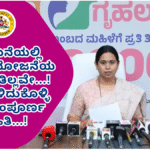Introduction
Processing arecanut (betel nut) has always been one of the most labor-intensive post-harvest activities in the plantation sector. Traditionally, arecanuts were dehusked, cut, dried, and polished manually — a process that demanded a lot of time and labor. With labor shortages and rising costs, farmers have been looking for more efficient and cost-effective alternatives.

To address this, the Karnataka Horticulture Department, under the Sub-Mission on Agricultural Mechanization (SMAM) and other allied schemes, has introduced a subsidy of up to 90% for the purchase of Arecanut Dehusking (Shelling) Machines.
Similarly, the department has also announced a high subsidy on Carbon Fiber Dhoti (Protected Cultivation/Greenhouse Structures) to promote modern and sustainable farming practices.
This initiative aims to reduce labor dependency, improve productivity, and encourage mechanization and scientific cultivation across the state.
1. About the SMAM Scheme
The Sub-Mission on Agricultural Mechanization (SMAM) is a flagship scheme of the Government of India, implemented through state departments of agriculture and horticulture. The goal is to promote the use of modern agricultural machinery and reduce manual labor in farming operations.
Under the SMAM scheme (2025–26), Karnataka farmers can now avail subsidies on a wide range of agricultural and horticultural equipment — including Arecanut Shelling Machines, Pepper Threshing Machines, Brush Cutters, and Post-Harvest Tools.
2. Subsidy Details for Arecanut Shelling Machine
Subsidy Structure
- General Category Farmers: Eligible for a subsidy of up to 50% on the purchase of approved machinery.
- SC/ST Farmers: Eligible for an enhanced subsidy of up to 90%, depending on the cost and category of equipment.
Subsidy Limit
- Subsidy amount generally ranges from ₹1 lakh to ₹5 lakh, based on the machinery type, capacity, and project estimate.
Inclusion of Arecanut Machine under SMAM
The Arecanut Dehusking (Shelling) Machine is specifically listed in the SMAM-approved equipment catalog. This means that farmers purchasing this machine from authorized vendors are eligible for direct financial support through the scheme.
3. Why Mechanized Arecanut Processing Matters
a. Saves Time and Labor
Manual arecanut shelling is slow and labor-intensive. The machine-based process can shell large quantities in a short period, drastically reducing processing time.
b. Reduces Cost of Production
By minimizing labor requirements, farmers can significantly reduce operational costs, leading to better profit margins.
c. Ensures Uniform Quality
Machines ensure even shelling, better drying, and uniform grading, which improves the overall market value of arecanuts.
d. Promotes Efficiency and Sustainability
Mechanization reduces physical strain on workers and improves efficiency in post-harvest management.
e. Encourages Youth in Agriculture
With the integration of modern technology, younger generations are more likely to participate in farming and agro-entrepreneurship.
4. Application Process for Subsidy
Farmers interested in availing the subsidy for Arecanut Shelling Machines or Carbon Fiber Dhoti systems can apply through their nearest Horticulture or Agriculture Office at the taluk or district level.
Required Documents:
- Land Ownership Proof (RTC or Pahani copy)
- Aadhaar Card – for identity verification
- Bank Account Details / Passbook Copy – for DBT (Direct Benefit Transfer)
- Caste Certificate – if applicable (for SC/ST beneficiaries)
- Proforma Invoice or Quotation from an authorized machine dealer
- Any other documents as specified by the Horticulture Department
Where to Apply:
- Taluk Horticulture Office
- District Panchayat (Zilla Parishad) Office
- Farmer Facilitation Centers (Raita Samparka Kendras)
- Online through official portals (e.g., K-KISAN)
Once the documents are submitted, field verification and approval are carried out by departmental officers. After approval, the subsidy amount is transferred directly to the farmer’s bank account (DBT system).
5. Carbon Fiber Dhoti (Protected Cultivation / Greenhouse System)
In addition to farm machinery, the Karnataka Horticulture Department is also promoting protected cultivation techniques such as Carbon Fiber Dhoti systems (Greenhouse setups).
These structures protect crops from excessive sunlight, wind, and pests, allowing farmers to grow high-value crops throughout the year.
What is a Carbon Fiber Dhoti?
A Carbon Fiber Dhoti is a modern greenhouse structure made of lightweight yet durable carbon fiber material. It helps regulate temperature, humidity, and sunlight to ensure consistent growth and higher yields of horticultural crops like vegetables, flowers, and saplings.
Benefits of Installing a Carbon Fiber Dhoti System:
- Year-Round Cultivation: Enables continuous production irrespective of external weather conditions.
- Higher Yield: Productivity increases by 2–3 times compared to open-field cultivation.
- Reduced Pest Damage: Crops are protected from insects, heavy rains, and excessive heat.
- Efficient Resource Use: Water, fertilizers, and space are used more efficiently.
- Improved Quality: Uniform size, color, and texture make crops more marketable.
6. Subsidy for Carbon Fiber Dhoti / Greenhouse
The Karnataka Horticulture Department provides substantial financial assistance to farmers who wish to adopt protected cultivation systems.
Subsidy Pattern:
- General Category Farmers: Up to 75% subsidy on the total project cost.
- SC/ST Farmers: Up to 90% subsidy available depending on the project scale and district allocation.
Implementation Agencies:
- Department of Horticulture, Government of Karnataka
- Department of Industries & Commerce (for large-scale protected units)
Official Portal for Application:
All applications must be submitted through the K-KISAN Portal (Karnataka Kisan) under the Protected Cultivation / Greenhouse Subsidy Section.
7. Application Procedure for Carbon Fiber Dhoti Subsidy
Step-by-Step Guide:
- Registration:
Visit the K-KISAN portal and register using your Aadhaar number and mobile number. - Select Scheme:
Choose the “Protected Cultivation / Greenhouse Subsidy” option under horticulture schemes. - Upload Required Documents:
- Land records
- Aadhaar and Bank details
- Project plan with dimensions (length & width)
- Quotation or cost estimate
- Submit the Application:
After submission, a field officer will inspect the site. - Approval & Implementation:
Upon verification, the department issues approval. Farmers can proceed with the installation through approved vendors. - Release of Subsidy:
After successful installation and inspection, the subsidy amount is released directly to the farmer’s bank account.
8. Why Farmers Should Apply Immediately
- Limited Allocation: Subsidy funds are sanctioned on a first-come, first-served basis. Applying early ensures eligibility.
- Rising Costs: Machinery and material costs may increase in the coming months. Early applicants benefit from current rates.
- Direct Benefit Transfer: Hassle-free payment directly to the farmer’s bank account.
- Long-Term Savings: Mechanization and protected cultivation both reduce operational costs and increase long-term profits.
- Government Support: Farmers also get access to training programs, free workshops, and technical guidance for maintenance and productivity improvement.
9. Expert Tips for Farmers
✅ Understand the Project Cost:
Check the model project cost, approved vendors, and subsidy limits before making a purchase decision.
✅ Attend Awareness Programs:
Participate in departmental workshops or farmer field schools to understand machine handling and greenhouse management.
✅ Consult Local Officers:
Discuss with the Taluk or District Horticulture Officer to get guidance on eligibility, documentation, and vendor selection.
✅ Keep Records Ready:
Maintain updated copies of land records, Aadhaar, and bank details to avoid delays in approval.
✅ Plan Efficiently:
Opt for equipment and greenhouse structures that suit your land area, crop type, and long-term farming goals.
10. Summary Table
| Particular | Details |
|---|---|
| Machinery Name | Arecanut Shelling / Dehusking Machine |
| Scheme Name | SMAM (Sub-Mission on Agricultural Mechanization) |
| Subsidy for General Farmers | Up to 50% |
| Subsidy for SC/ST Farmers | Up to 90% |
| Financial Limit | ₹1 lakh – ₹5 lakh (depending on machine type) |
| Eligible Applicants | Individual Farmers, FPOs, SC/ST Farmer Groups |
| Required Documents | Aadhaar, Bank Details, Land Proof, Caste Certificate, Invoice |
| Contact Points | Taluk Horticulture Office / Farmer Facilitation Center |
| Online Portal | K-KISAN Portal |
Conclusion
The Arecanut Shelling Machine and Carbon Fiber Dhoti Subsidy Schemes represent a major step forward in Karnataka’s agricultural modernization efforts. These initiatives not only make farming more efficient and less labor-dependent but also pave the way for sustainable and climate-resilient agriculture.
With up to 90% financial support, farmers — especially those from marginalized communities — have a golden opportunity to modernize their farms, improve productivity, and reduce costs.
👉 Farmers are encouraged to apply immediately through their nearest horticulture office or the K-KISAN online portal to make the most of this government initiative.











